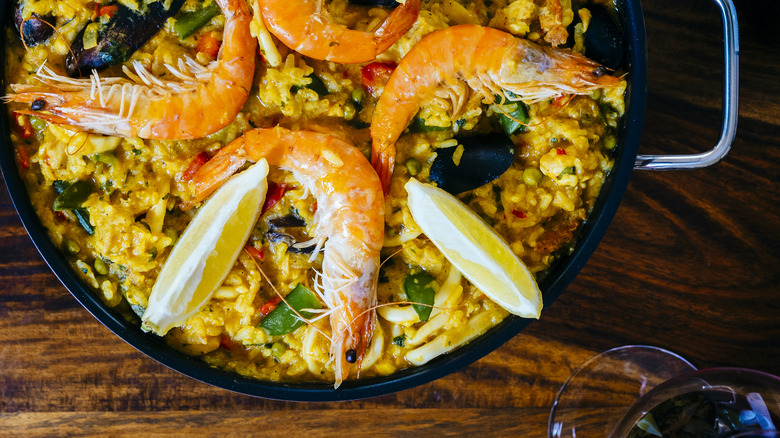The Secret To Making The Ultimate Paella For National Hispanic Heritage Month
National Hispanic Heritage Month – the annual observation of Hispanic American culture with roots from countries including Spain, Mexico, Cuba, and South and Central America — will span September 15 to October 15, 2024. During this time, the celebration invites revelers of all backgrounds to enjoy the many beautiful expressions of these rich cultures. Of course, for food lovers, that means especially highlighting the many culinary treasures that have transcended borders, been passed down through generations, and generously shared with the world.
One of those classics is paella. Have you ever seen this impressive party-ready food and wondered what is paella? Hailing from Valencia, Spain, this is a dish that's actually named for a pan — the large, round, iconic vessel with shallow sides in which paella is prepared. With its deeply complex flavors, thanks to its iconic use of saffron and vibrant spices, contrasting textures, and abundance of proteins and vegetables — not to mention the ritual of its creation, which encourages gathering and sharing — paella is a special occasion all on its own.
But there is a secret to making your paella worthy of celebration — and it lies in the stock. This liquid is the foundation of the entire dish, so it's critical that your broth is loaded with flavor. Fortunately, this is something you can create naturally right at home in the early steps of the paella process, easily and from ingredients you'll use in your finished dish.
Types of broth and ingredients to use for paella
Creating your paella stock is a matter of layering flavor, and that idea applies no matter which style you choose. In a seafood paella, for example, this means sautéing ingredients like prawn heads along with bright parsley and salt, then adding white wine, the liquid from briny mussels — and, of course, that signature dose of earthy, fragrant saffron. For a chicken paella, you might begin with sautéed onion, bell peppers, and alliums like garlic and onion. From there, add a bay leaf along with the saffron and a selection of spices like paprika (for a smoky tinge and boost of color), then cook it all down with white wine. You can even create a vegetarian paella, in which case your stock will pull from similar elements, including the aforementioned alliums, spices, and wine, but also tomatoes, green peas, or garbanzo beans.
Many recipes call for combining your wine-based broth beginnings with a prepared stock like chicken or vegetable when it comes time to cook your rice. That means you can lean on a store-bought option if you don't have a homemade version, as you're essentially taking steps to upgrade that liquid with the flavors you've already developed, and that will make your paella unique. In any case, as you draw the most from each ingredient, you're able to infuse every element with multidimensional flavor that comes through in the finished product.
Putting your paella together
Once you have a powerfully flavored, fragrant, and layered stock, where you take your paella is entirely up to you. If you're in search of a codified list of ingredients that constitute traditional Valencian paella, that would be difficult to pin down and is even hotly debated in its place of origin. But in addition to the elements you choose to use in your stock preparation, traditional proteins can be everything from mussels, prawns, and squid in a seafood version to chicken, chorizo, and rabbit in a meat eater's classic.
One element that is generally agreed upon is that the best paella rice is Spanish bomba, a short grain rice that will be super absorbent, thus making good use of the stock you worked to develop and carrying those nuances through to the finish. Another element of traditional paella is a smokiness that comes from being cooked over an open flame. If you are planning to make yours indoors on the stovetop, though, you can find ways to incorporate that character through other methods, like smoked salt (luckily, a microwave is all you need to make this mouthwatering stuff). But regardless of how you make your paella or which ingredients you select, leaning on a stock created step-by-step with care will ensure your National Hispanic Heritage Month celebration has the centerpiece it deserves.


